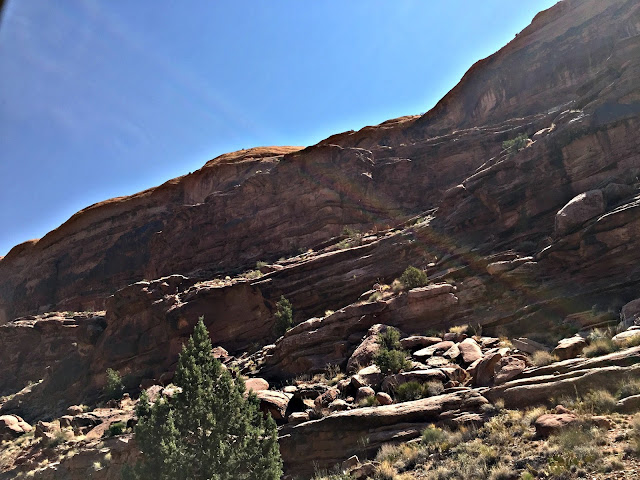
Excerpts are from Wikipedia
State Route 279 is a state highway in the U.S. state of Utah. The highway was constructed in 1962–1963 to service the Cane Creek potash mine and processing plant southwest of Moab. The highway was named one of the most beautiful highways opened to traffic in 1963.
The entire length of SR-279 has been designated the Potash – Lower Colorado River Scenic Byway by the Utah State Legislature,[2] however is known locally as Potash Road.[3]
This highway was intended to be part of a longer highway, State Route 278, that was to scale the canyon walls between Moab and Dead Horse Point State Park. Only the connection to the potash mine was constructed before the project was cancelled.
Although the highway was constructed to aid the mining industry of southeastern Utah, the road is popular with tourists and four wheel drive enthusiasts. The jeep trails beginning where SR-279 ends are used to access Canyonlands National Park and Dead Horse Point.
The highway begins just north of Moab at a junction with U.S. Route 191 near the southern boundary of Arches National Park. The road follows the north bank of the Colorado River to the potash mine.
The road is legislatively designated north–south, but actually serpentines for most of its length.
The highway loosely parallels a spur of the Denver and Rio Grande Railroad built at the same time and for the same purpose of serving the potash mine.
The route of the railroad features a 1.59-mile (2.56 km) tunnel that bypasses most of the serpentine bends in the Colorado Riverbetween Moab and the potash plant.[4]
While in the Colorado River canyon, the highway passes by dinosaur footprints, Indian petroglyphs and jeep trails leading to Canyonlands National Park and Dead Horse Point State Park.
The highway also passes by three named natural arches, Corona Arch, Bow Tie Arch, and Jug Handle Arch.[2][3]
The others finalists were I-93 between Windham and Londonderry in New Hampshire, I-84near Southington, Connecticut and I-405 near Sepulveda Pass in Los Angeles, California.[10][11]
potassium chloride, also known as muriate of potash. Picture below is from Wikipedia:
Intrepid Potash, Inc. (NYSE: IPI), based in Denver, Colorado, is the largest producer of potassium chloride, also known as muriate of potash, in the United States.[1] It owns three mines, all in the Western U.S., near the cities of Carlsbad, New Mexico, Moab, Utah, and Wendover, Utah.[2]
 |
| This is the Plant. Which was also the end of the road. |
The Moab or Kane Creek potash mine (38°31′25″N 109°39′15″W) is located along the right (northwest) bank of the Colorado River, about 20 miles (30 km) west of Moab, Utah,[3] at the south end of State Route 279 and the Union Pacific Railroad. The location is known as Potash on U.S. Geological Survey (USGS) topographic maps, and is east of Dead Horse Point State Park and Canyonlands National Park.[4] According to USGS reports, the Paradox Basin contains up to 2.0 billion tons (1.8 billion metric tonnes) of potash, with the primary mine being the one at Cane Creek.[5]
The plant was built by the Texas Gulf Sulphur Company in the early 1960s,[6] opening in 1963 as a conventional underground mine.[7]Later that year, an explosion trapped 25 miners,[8] of whom only seven were able to survive, by building a barricade to trap fresh air.[9]
In 1970, operations were changed to a system that combines solution mining and solar evaporation. River water is pumped into the mine and dissolves the potash, after which the brine solution is pumped to evaporation ponds.[3] Intrepid bought the mine in 2000[10]from the Potash Corporation of Saskatchewan,[11] which had bought Texas Gulf in 1995.[12]
































No comments:
Post a Comment